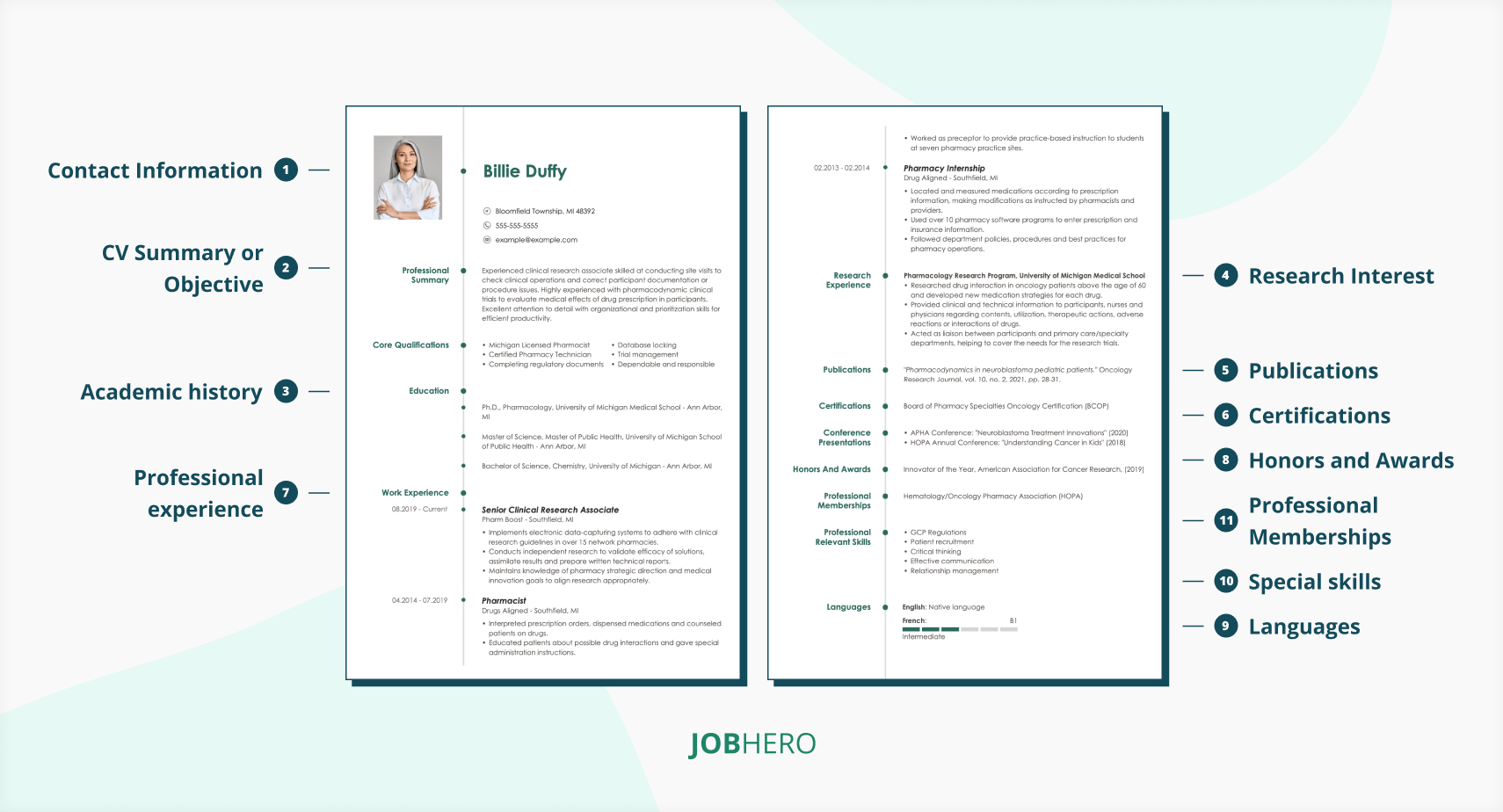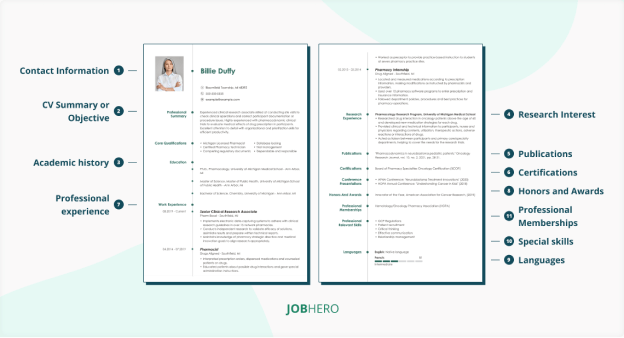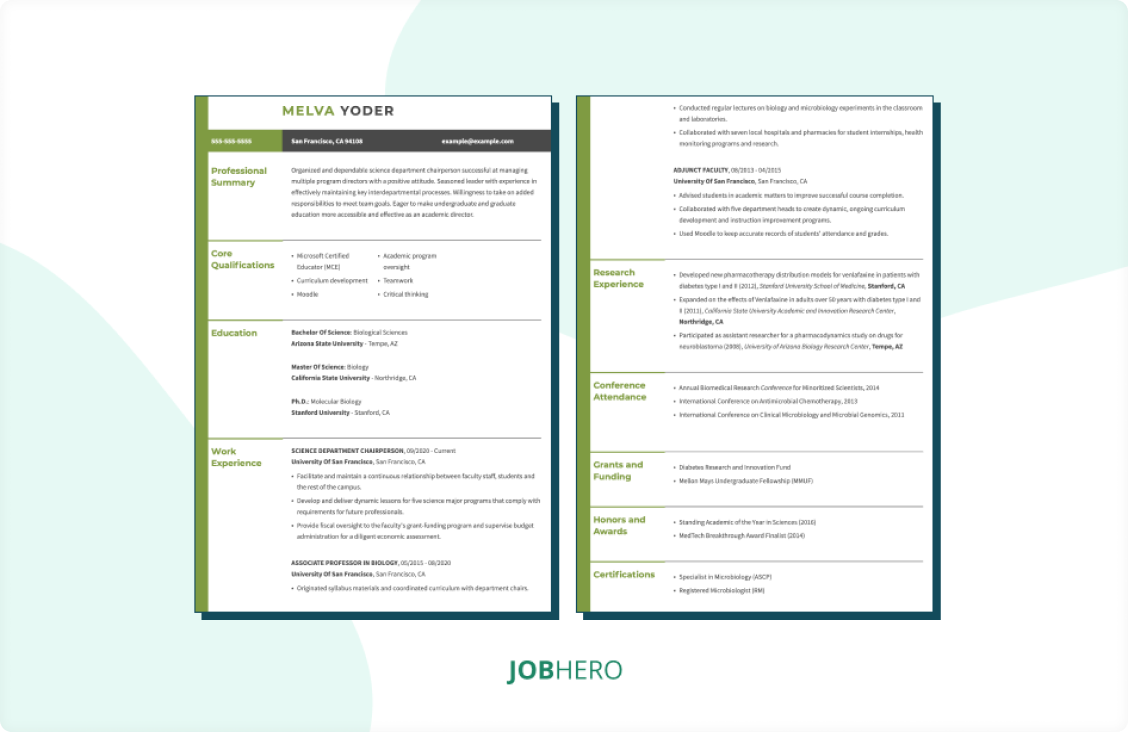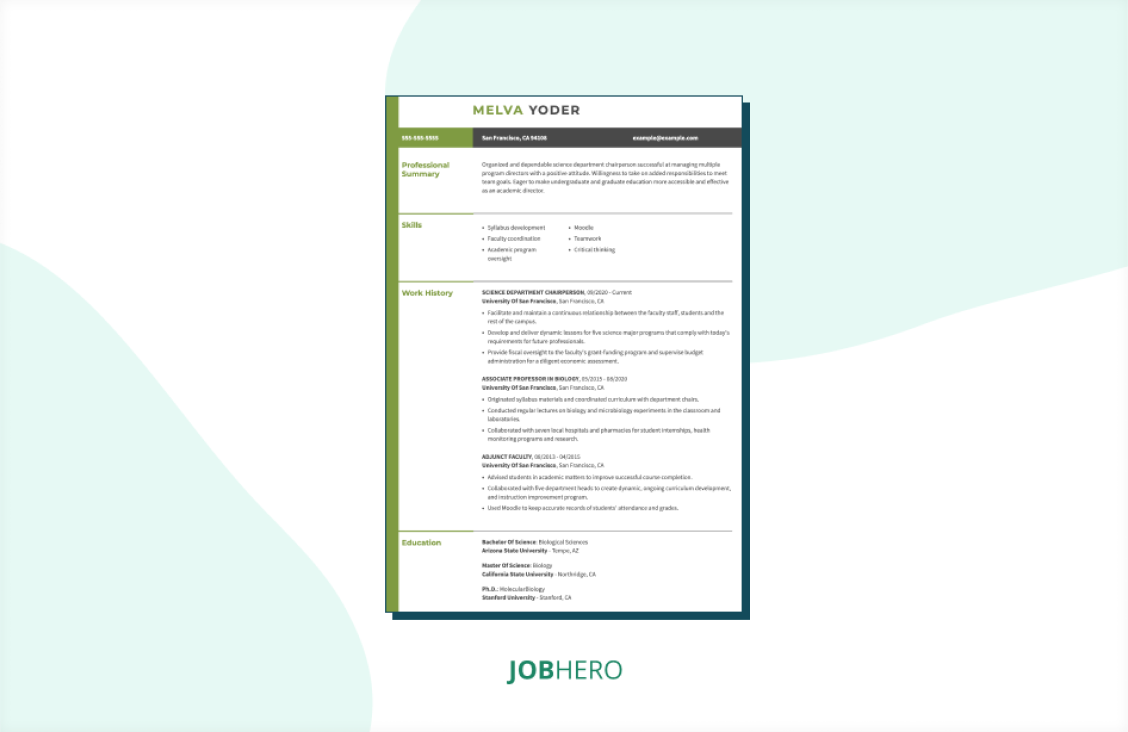What Is a CV?
A CV, or curriculum vitae, outlines your professional experience, education, skills, and achievements. This is the standard document for most academic positions, research opportunities and international job applications.
A well-formatted CV provides a comprehensive overview of your qualifications. Unlike a resume, a CV is longer and includes unique CV sections. Your CV may include a combination of the following sections.
Your CV will always include:
-
Contact information
-
CV summary
-
General skills
-
Professional experience
-
Education
Your CV might include these sections based on your professional experience and current job goals:
-
Academic history
-
Research interests
-
Publications
-
Presentations
-
Scholarships, honors and awards
-
Languages
-
Licenses, certifications, special skills and achievements
-
Professional memberships or affiliations
Wondering how to create a CV? Save time and hassle by using our CV Builder. Designed with AI-powered tools to auto-suggest phrases and keywords relevant to the industry that you are applying to.
These sections can be listed differently, depending on which areas you want to highlight. With this in mind, here’s some essential guidance on how to write a good CV, section by section.
How to Write a Professional CV in 7 Steps
1 Format your CV
Your CV format should follow the standard layout to pass ATS scans and maximize readability:
-
1-1.5 inch margins.
-
10, 11 or 12-point text.
-
Fonts like Helvetica, Arial or Geneva.
-
Bold and 14-point section headers.
-
Bullet points.
2 Add your contact information.
Your CV will begin with your name and contact information. Start with your full name in a prominent and bold font. Then, add your current contact information, including your email and phone number.
How to write a CV header:
April Barnes Portland, OR 555-555-5555 example@example.com

3 Learn how to write a CV summary.
A CV or professional summary is a three- to four-sentence defining statement that tells employers your expertise and achievements. Keep it concise and relevant by customizing this section to match the job description. Here’s an example:
“Dedicated and detail-oriented Physics Ph.D. candidate specializing in particle physics focusing on Higgs boson research. Proficient in advanced data analysis, simulation tools, and experimental design. Experienced in collaborating on large-scale research projects, presenting findings at international conferences, and publishing in peer-reviewed journals. Passionate about advancing knowledge in fundamental physics.”

4Share your academic history.
If you’re applying to a grad program, educator or research position, your education section will sit above your work experience. Add the school’s name, the year you graduated and details such as the title of your dissertation or thesis.
Your CV should list your education in reverse chronological order. For example, after a Ph.D., list other postgraduate degrees, such as a master’s degree, and then your undergraduate education.
Here’s a sample of how to write a CV education section:
Education
Master of Science in Physics | University of Michigan Ann Arbor, MI | Graduation Date: June 2024
Bachelor of Science in Physics | University of California, Berkeley Berkeley, CA | Graduation Date: June 2020

5 Detail your professional experience.
Outline your work history with a section that lists the names of all the organizations or companies where you’ve worked, your job titles, the dates of your employment and a summary of your skills and achievements. Include hard, soft and technical resume skills.
Here’s a work history sample for an undergraduate physics student:
Undergraduate Research Assistant – Hadron Collider Experiment SLAC National Accelerator Laboratory, Menlo Park, CA January 2019 – December 2019
-
Assisted in high-energy particle collision experiments focused on Higgs boson detection and decay processes.
-
Analyzed large datasets using Python and ROOT to identify particle signatures and anomalies.
-
Collaborated with a multidisciplinary team to optimize detector performance and data accuracy.
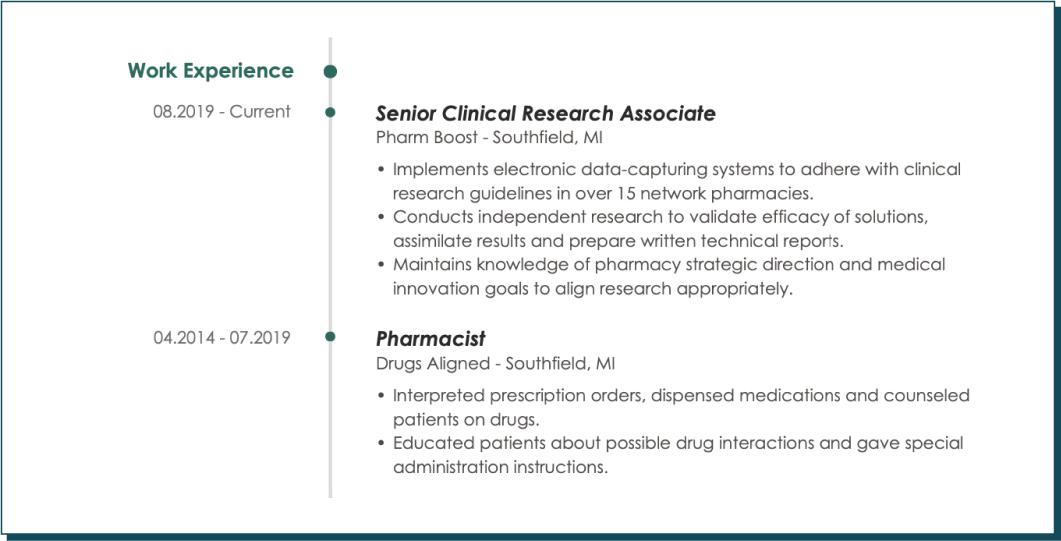
6 Add licenses, certifications, special skills and achievements.
Include licenses, certifications, and achievements in dedicated sections or under relevant headings. List them in reverse chronological order, providing the name, issuing organization, and date. For example, this Ph.D applicant graduated with high honors and could list them as:
Bachelor of Science in Physics | Stanford University Palo Alto, CA | Graduated: June 2018 Salutatorian in a class of 230. Honors: Dean’s List
Create multiple, dedicated skill sections based on the application needs, such as math skills, technical skills or analytical skills. For example, this undergraduate might list their research skills in the following format:
Research Skills
-
Data analysis and interpretation
-
Spectroscopy and photometry data reduction
-
Science communication skills
-
Telescope operation
-
Proposal writing for telescope time allocation

7 Describe your research interests.
A CV tells the complete story of your academic and professional history, so you can add as much information as you need. Consider including any of the following:
Research interests: If you’re an academic researcher, list your main focus areas.

Publications: List any publications, including books and peer-reviewed journals. Include a complete citation with the co-authors’ names, publication date and a summary.

Presentation: Mention lectures, conferences and presentations given. Provide the title, date, venue and a summary of the subject matter.

Scholarships, honors and awards: Detail any honors, grants, fellowships, scholarships or awards you earned. Write the name of each grant or scholarship, the awarding institution and the date you received it.

Languages: It is always an excellent strategy to show your multilingual fluency. Remember to mention your level of mastery.

Professional memberships and affiliations: Include any relevant professional memberships and affiliations. List each organization’s name, location and the dates of your active membership.

CV Versus Resume: When to Use a CV?
CV
Purpose: Resumes are typically used to apply for most jobs. CVs are credential-based and submitted for academic, scientific research and medical positions.
Location: You’ll only need to learn how to write a CV if you’re seeking jobs outside of the U.S. or academia. Resumes are the norm in the U.S.
Focus: A CV details your career, education, awards and scholarships. A resume is a snapshot of your most significant work achievements and skills.
Length: CVs can run several pages, while resumes usually are one page.
Resumes
When to use a CV?
You would typically need a CV to apply for international jobs. In the U.S., applicants should opt for a CV when applying for federal, academic and research positions. You may also be asked to submit a CV if you apply for a fellowship or grant.
Here are a few of the jobs that may require a CV:
-
Scientists
-
Academic researchers
-
Art curator
-
Teachers
-
Professors
-
Clinicians
-
Federal jobs
Do’s and Don’ts to Make Your CV Stand Out
- Start your CV strong. Use your summary, skills and critical accomplishments to attract the recruiter’s attention.
- Do focus on the visual appearance of your CV. Use a CV template with easy-to-read layouts.
- Always proofread your CV to avoid grammatical errors. Have a second pair of eyes read your CV, not only for typos and spelling but also for general readability.
- Avoid being outdated and only use information that is relevant to the job.
- Avoid light summaries; instead, use the opportunity to create compelling descriptions of your skills and accomplishments.
- Do not include references or write “References available upon request.”
- Never lie or exaggerate information on your CV.
CV Tips to Get Noticed by Recruiters
The average time hiring managers or recruiters spend reviewing a CV is six to eight seconds. Additionally, recruitment agencies usually rely on ATS and AI screening tools to scan for candidates. Considering this, let’s review how to write a CV for a job application and the five best tips to get recruiters to notice your CV.
Use a Cover Letter to Express Yourself
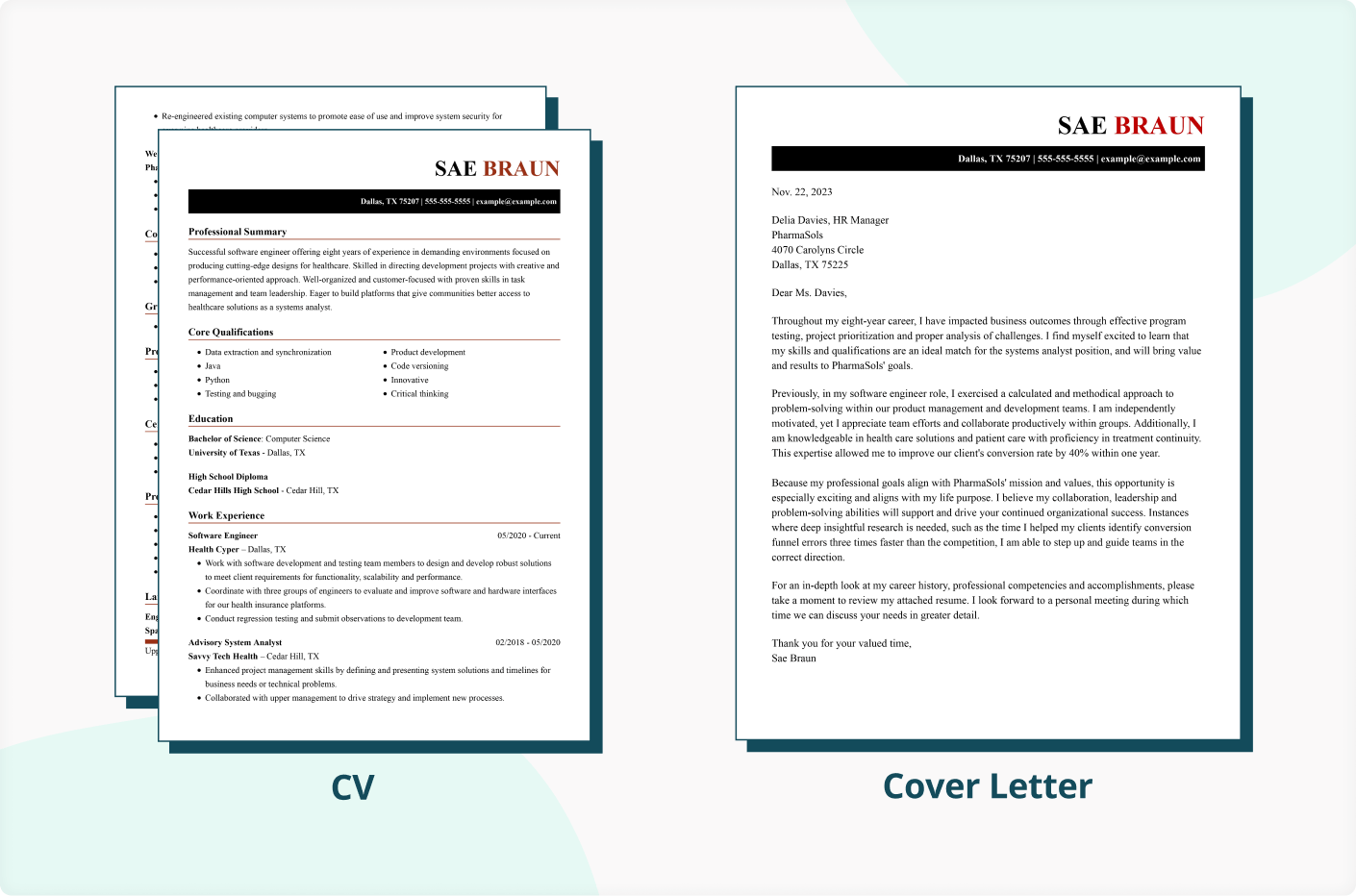
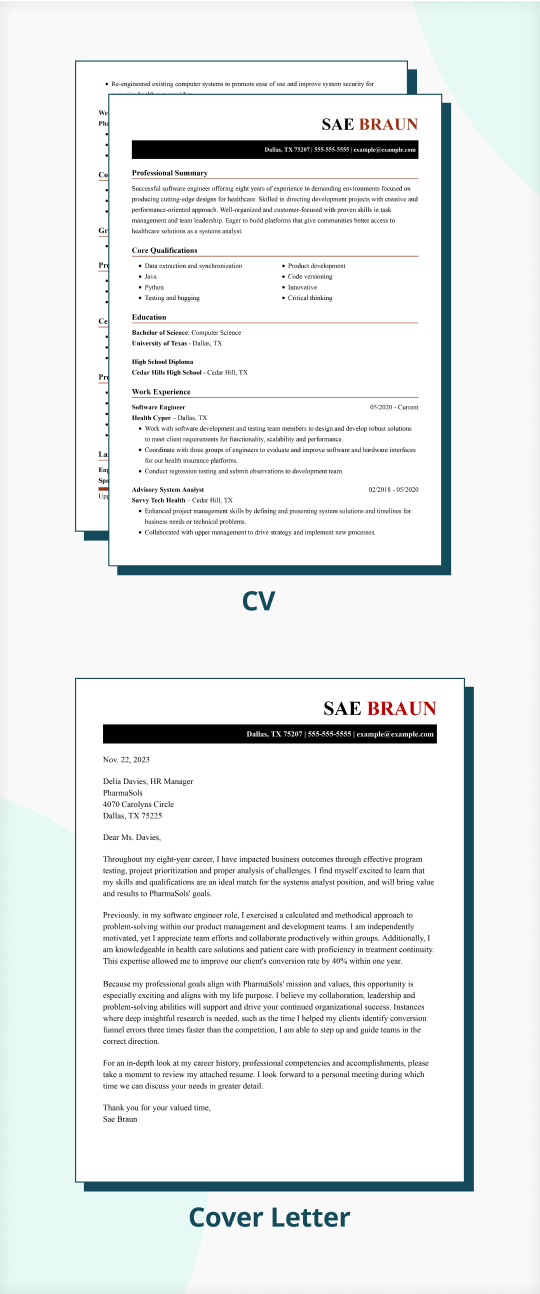
A cover letter can expand further on the foundation you created with your CV. Add a cover letter to share one or two examples of how you excelled in similar roles or how your skills match a company’s needs. Use this sample as a guide, or visit our helpful resources to boost your application.
How to Write a CV FAQ
Is a CV the same as a resume?
CVs and resumes include information about your work history, academic background and professional skills. However, a CV is a more detailed account of your entire career. A resume is a concise summary tailored to the specific job you’re applying for.
What should a CV look like?
A CV should be clean, professional, and easy to read. Use these design tips to avoid a cluttered document.
- Use consistent margins set to 1-1.5 inches.
- Add bullet points for clarity.
- Traditional fonts like Helvetica or Arial.
- Bold section headers.
- 10, 11 or 12-point text.
What makes a good CV?
A good CV shares these qualities:
- Defines skills that align with the job requirements.
- Demonstrates you understand the company’s objectives and can contribute to their success.
- Proves easy to read and understand.
- Presents genuine and honest credentials and information.




